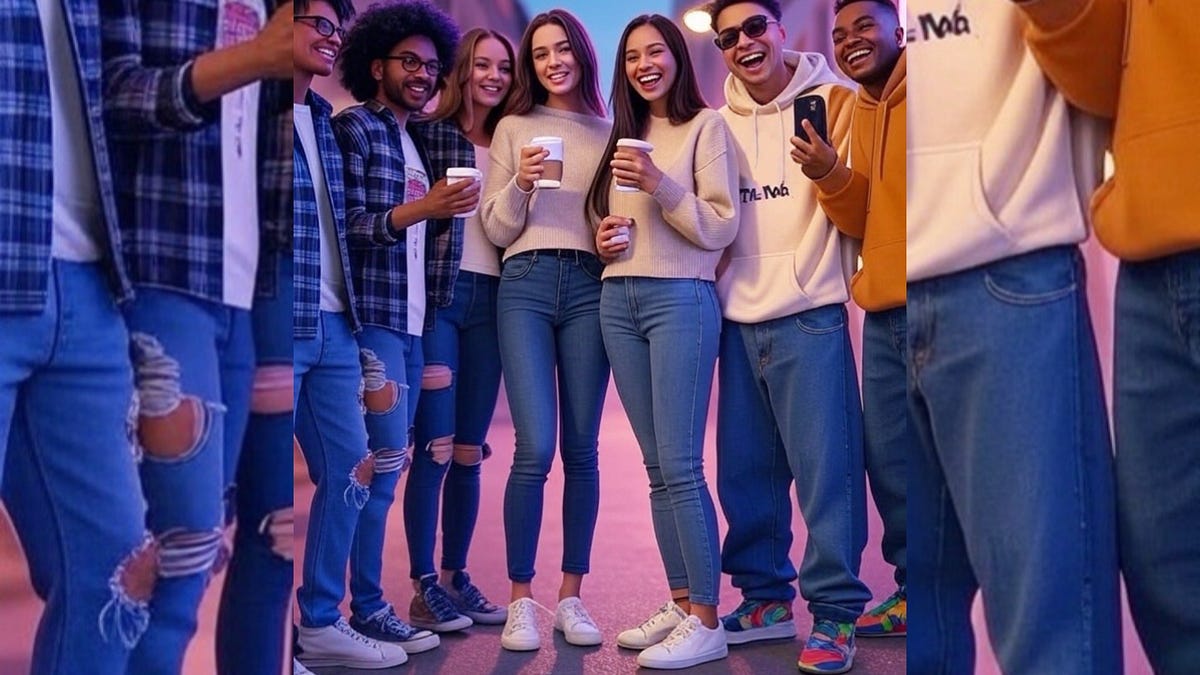From Boomers vs Gen X to Millennials vs Gen Z, fashion has always marked generational battles, and TikTok just makes them harder to ignore.
Why Generational Fashion Wars Always Come Back
A recent New York Post article highlighted a recent trend where Millennials are copying Gen Z’s looks and slang, sparking both amusement and ridicule online. Videos of Millennials in baggy jeans or experimenting with Gen Z slang get pushed into millions of feeds, where the response is usually split between encouragement and mockery.
As someone from Gen X, it feels familiar. I remember watching Boomers shake their heads at ripped jeans and plaid shirts, only for my generation to laugh at their perms and golf polos. Now I watch TikTok and see Millennials mocked for their skinny jeans and beige mugs. The conflict is the same, only this time the whole world gets a front-row seat.
Boomers, Gen X, and the First Style Rivalries
Long before TikTok, style battles happened around kitchen tables, in school hallways, and in the pages of glossy magazines. Boomers leaned on high-waisted pants and conservative looks, while Gen X tore holes in jeans, wore Doc Martens, and pushed grunge into the mainstream. To parents, we looked sloppy, but to us they looked stuck in the past.
Fashion became the language of rebellion. We set ourselves apart through deliberate anti-style: oversized plaid flannels, band tees, black eyeliner, and thrift-store finds. We rejected polish, consumerism, suburban uniformity, and the “yuppie” culture of the 80s. Our fashion was messy by design, a middle finger to what came before.
Millennials rejected the overly casual, messy rebellion of Gen X. Instead of ripped jeans and thrift-store grunge, they leaned into a more curated, polished aesthetic. They squeezed into skinny jeans, embraced bright “millennial pink,” Instagram-worthy brunch outfits, and fast-fashion cycles from Zara and H&M. For Millennials, those choices were about carving out their own identity in a decade shaped by debt from the 2008 recession and unstable jobs.
TikTok and the Millennial vs Gen Z Battle
Now Millennials face what we once thought of our parents’ fashion and sense of style. Gen Z uses TikTok to roast Millennials fitted jeans, and beige interiors homes. The Guardian covered the so-called “skinny jeans war,” and Vox explained explained how even hair parts became a generational marker. What might once have been a throwaway joke became a viral video with millions of views.
Millennials didn’t just get roasted, they’re trying to adapt. Some copy Gen Z’s baggy pants, slang, or ironic humor in hopes of looking current. Sometimes it works, but mostly it backfires, feeding TikTok’s endless cycle of memes. The platform rewards generational teasing because mockery gets views. Even minor differences in style get exaggerated and shared worldwide overnight.
Y2K Excess, Cottagecore Calm, and Millennial Identity
Part of why Millennials feel the sting is that they already lived through big aesthetic changes of their own. The Y2K era meant metallic fabrics, rhinestone belts, velour tracksuits, butterfly clips, and lip gloss that sparkled under mall lights. It was colorful and loud, tied to MTV, mall culture, and nights out that felt carefree.
Then came Cottagecore with a completely opposite mood. It grew popular during the pandemic and was defined by linen dresses, picnics, sourdough bread, and candlelit homes. It’s describes as an idealized vision of rural life. Cottagecore projected calm in a time of burnout and global anxiety.
These aesthetics showed how Millennials used fashion to cope with change. Y2K reflected optimism before the financial crash, while cottagecore became a survival mechanism during global stress.
The cottagecore trend is one both Millennials and Gen Z have embraced. Gen Z has remixed it into other trends like goblincore or fairycore. Rather than being laughed at, cottagecore has become a shared generational escape hatch in the fashion wars. For older generations (Boomers), cottagecore was prairie dresses, handmade quilts, or back-to-the-land movements. A reminder that trends never vanish, they just return under new labels.
Fashion, Stress, and Why the Cycle Repeats
Every generation thinks it invented rebellion, but the cycle always repeats itself. Boomers mocked Gen X, Gen X rolled its eyes at Millennials, and now Gen Z is getting laughs at Millennials’ expense. TikTok just gives it a louder megaphone.
Fashion has always been about more than what hangs in a closet. It shows how each generation processes stress, identity, and survival. Y2K excess reflected optimism, cottagecore offered retreat, and Gen Z’s baggy irony reflects their own search for authenticity and to assert their identity.
One day they’ll be roasted too, probably on a platform even louder than TikTok. Every generation becomes a target, and fashion is where the jokes first land. From where I sit as Gen X, it all feels familiar. The players and styles change, but the message stays the same: know your generational boundaries or else.
Share your thoughts or stories below 😊
Read my other Medium article: Gen Z Is Ditching Hustle Culture: Inside the Rise of the Soft Life Trend on TikTok.
If you’re feeling burned out at your job, read my book:
📘Burnout to Balance: Your 8-Step Guide to Thriving in a Messy Workplace
